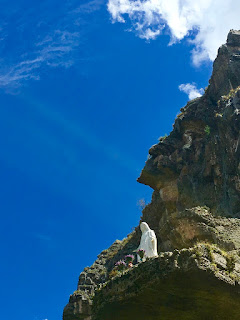For those with a spare minute to kill, I appreciate you
killing it here with me. I, myself, found a rare handful of extra time and
realized I am beyond due for a brief update / meandering of thoughts for all of
my family, friends, and what-ever-happened-to-that-guy acquaintances.
If you have not otherwise been updated on the life and times
of yours truly, I moved to Bogota, Colombia in June 2016. For those of you
keeping score at home who may have lost track along the way, here is a quick
update to get us all up to speed:
2011: Antigua, Guatemala
Jan-July 2012: Lima, Peru
July 2012 – February 2013: San Salvador, El Salvador
February 2013 – June 2016: Washington DC
June 2016 – Present: Bogota, Colombia
Now, after four months of making this city my new home, I feel
inspired to share a sliver of this life with those of you who have ever
wondered, “What is it like for a 30-something, white, single guy from the mean
streets of Grand Blanc, Michigan living in Colombia?” Especially after the
numerous conversations keeping in touch with many of you via email, WhatsApp,
FaceTime, etc. (thank science and modern technology), I thought it’d be
interesting to share some of my musings on my Andean experience thus far for
all to feast upon. Looking ahead, I hope to share some more thoughts more
frequently, so check back often.
Narcos
Let’s cut right to it: it is almost guaranteed that the
first thing most Americans think of when they hear “Colombia” is cocaine, or a
related topic like Pablo Escobar and narcotraficantes. Especially amidst the
popularity of Netflix’s original series, Narcos, Americans back home are being
taught this history (albeit, in all its Hollywood fabrication), and it comes as
no surprise that this is STILL the Colombia that Americans picture today. Hell, I love that show – no knock on that – but it’s a bit silly that
people haven’t bothered to look in a book or do a basic Google search to update
their Colombian stereotypes beyond the year 1994. I mean, give me some Shakira,
a Sofia Vergara / Modern Family reference, or even some Juan Valdez coffee
talk.
My kind of Colombia
In all seriousness though, the Pablo Escobar /
shoot-the-captain-of-your-national-soccer-team-upon-returning-home-to-Colombia-because-he-scored-on-his-own-goal-in-the-1994-World-Cup era is a very important part of Colombia’s history. However, it is only a small
part of an otherwise rich history and culture, and today Colombians proudly
proclaim that this era is behind them and you really
feel that when they tell you this. As infamous as Pablo Escobar may be,
it’s really quite remarkable how much of a name the guy made for himself and
what a place in history he holds. I, and most normal people, by no means
respect or admire what he did, but it is an interesting exercise to ask yourself,
“How many people throughout history can you identify that, in a way (
good or bad) put their country and an
era on the map?” That just by mentioning that person’s name, most everyone can
say where they hail from and most everyone has at least a basic understanding
of why they are known.
Gandhi, Hitler, Lincoln, Mao, Elvis, Mandela, Lennon, Lenin…
Kitler
Maybe Pablo Escobar doesn’t belong among this group of
titans, but I’d argue he is close.
Anyhow, anyone who has been to Colombia since the 1990s can
tell you that a lot has changed, and has changed for the better. Of course, the
internal conflict with the FARC rebels is still, technically, ongoing, but the terrorist
reign of Escobar and bombs in the streets is a time that Colombians proudly
proclaim has passed. Crazy enough, a small mall one block around the corner from
my office – one that I walk by every day – was the site of a car bomb set off
by Escobar in the 90s. Hearing that from a friend of mine one day as we
strolled by after eating lunch really blew my mind. This is a place that I go
into once a month to exchange my pesos and to pay my phone bill, and it by no
means screams “I once played a role in the craziness that was Colombia in the
90s.” Yet, here it was – a relic of such a defined era, but invisible and unknown
to people like me and, most likely, tons
of young Colombians who were lucky enough to be born after such an era.
Like any place on Earth, Colombia still faces its challenges
(e.g.
recently voting down a peace treaty to end the civil war with the FARC),
but I would say – in my humble opinion – that Colombia is a thriving country
with lots of beauty, hope, and opportunity to offer; NOT a “third world
country” (yet another outdated term, so please stop living in the 1980s Cold
War). While I am by no means an expert on Colombia and would not dare to speak
on behalf of other Colombians, my four months here has afforded me a brief
glimpse of what life is like here. And I will say that in those four short
months, it has become clear to me that the stereotypes of cocaine, Pablo
Escobar, and drug dealers are not taken in jest by Colombians.
That is definitely something I have very quickly come to
love and respect about the Colombian people. They may be divided over which
beer is the best or what local soccer team is better, but they are uniformly resolute
on reshaping and polishing their image; and not only for foreigners and their
perceptions of Colombia, but for themselves. To me, that is admirable and
inspiring. When people can otherwise be divisive and bitter over challenges
that face their country (read the 2016 US presidential campaign), it is
relieving to see so many different people united to do what is best for their
homeland.
The weather
I hate to squander the opportunity this forum presents to
drone on about something as mundane as the weather when I could instead crack
into more interesting topics like $3 lunch menus, beautiful women, or the ridiculousness
of Bogota traffic. However, the weather is something that – although not
drastically different from other climates I have lived in – sticks out to me.
When asked to describe Colombia, most people will rattle off adjectives fit for
a tropical paradise: palm trees, beaches, blue oceans, a scorching sun. All of
these things can certainly be found in Colombia, but you will not find them in
Bogota.
Most are surprised to hear that Bogota is found in the
mountains and valleys of the Andes Mountains, at over 8,000 feet of elevation (the
“Mile High City” of Denver, for example, is only about 5,500 feet). This not
only places Bogota among the highest cities in the Americas, but makes it the
third highest capital city in the world (behind La Paz and Quito, which are
–surprise, surprise – also located in the Andes). Given the elevation, Bogota
is a pretty cool city with average temperatures hovering around 65 degrees year
round.
Mastication
The weather here is a perpetual fall. So far, this has
excited me since – being from Michigan – I love a beautiful autumn day when I
can carb load on powdered donuts at the apple orchard and watch American (i.e.
real) football. Bogota has that same vibe: crisp air, but not cold enough to
warrant more than jeans and a light jacket, a nice grey overcast sky, and a
slight breeze. The sun will often peek out during the morning hours, which
warms things up quite a bit given the high altitude, but the afternoons often
bring heavy, tropical rains. During a typical day during the rainy season It
truly is like getting 3 seasons (spring, summer, and fall) all in one day
around here.
Greyest of blue skies
All that said, Bogota – in regards to its climate – is not
on the top of my list of recommended places to visit in Colombia. It is a huge,
vibrant city with exciting things going on (perhaps a topic for another post),
but I sense most people would be let down without this dose of reality from
yours truly when their plane lands and they find that shorts and flip flops
were not the appropriate wardrobe choice.



































